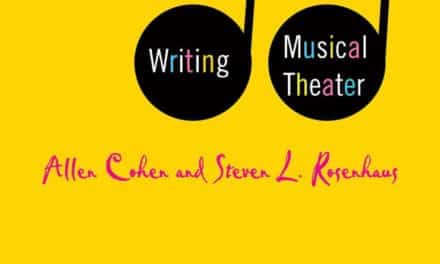
• • •
Finding a Musical Style:
How Do You Find the Right Sound for Your Score?
“Trust your audience, kid. They’re just as smart as you are.”
– Lorenz Hart (to a young Richard Rodgers)
Notes on Broadway: Intimate Conversations With Broadway's Greatest Songwriters
- Leonard Bernstein talks about striking a balance between the “poetic” and “realistic” in the score for ‘West Side Story’ (pg. 15)
- Cy Coleman values research (pg. 52)
- Cy Coleman hits on comic opera for ‘On the Twentieth Century’ (pg. 52)
- Betty Comden says improvisation lead to the comic opera flavor of ‘On the Twentieth Century’ (pg. 69)
- Marvin Hamlisch starts with a rhythm (pg. 143)
- John Kander concentrates on developing “riffs” (pg. 198)
- Henry Krieger finds “a different musical tone for each personality (pg. 212)
- Charles Strouse admits to writing a hit song for ‘Annie’ that’s out of style with the rest of the score (pg. 282)
- Jule Styne shuts out all other music to focus on writing for character (pg. 288)
The Art Of The American Musical: Conversations With The Creators
- Betty Comden talks about when her collaborators did and didn’t write a pastiche score (pg. 65)
- Stephen Sondheim talks about finding his “voice” in the score to ‘Company’ (pg. 195)
- Stephen Sondheim describes how harmony can give a score “character” (pg. 199)
- Charles Strouse does “a great deal of sketching” (pg. 225)
- Stephen Flaherty respects tradition (pg. 2)
- John Kander says he listens and listens to music from the era in which his show is set, and then tries to forget it (pg. 104)
- Burton Lane sets the title of ‘On a Clear Day”,” and then it takes Alan Jay Lerner nine tries to write the rest of the lyric (pg. 129)
Ever After: The Last Years of Musical Theater and Beyond
- Garth Drabinsky identifies his favorite style of theater music (pg. 176)
- Adam Guettel describes finding a musical language for ‘Floyd Collins’ (pg. 119)
- Adam Guettel focuses on giving actors a score that prompts them to give energetic performances (pg. 123)
- Julie Taymor pieces together a score for ‘The Lion King’ from multiple sources (pg. 148)
• • •
Finding A Musical Style:
To Rhyme or Not to Rhyme?
- Irving Berlin’s “word sounds” trump clever rhyming in ‘Can’t Help Singin’ by Gerald Mast (pg. 43)
- Irving Berlin explains what makes Lorenz Hart “the first of the sophisticated word writers” in ‘Thou Swell Thou Witty’ by Dorothy Hart (pg. 185)
- Philip Furia analyses Lorenz Hart’s “addiction to rhyme” in ‘Poets of Tin Pan Alley’ by Philip Furia (pg. 95)
- Tom Jones decides not to rhyme “love” (more that once) in “My Cup Runneth Over” from ‘I Do! I Do!’ in ‘Making Musicals’ by Jones (pg. 151)
- John Lahr praises Yip Harburg’s “subliminal” rhymes in ‘Honky Tonk Parade’ by Lahr (pg. 191)
- Arthur Laurents assesses ‘West Side Story’s lyrics in ‘Original Story By’ by Laurents (pg. 351)
- Pamela Phillips Oland suggests modern day “Cole Porters” think about the “language of today” in ‘The Art of Writing Great Lyrics’ by Oland (pg. 51)
- Arthur Schwartz defends Lorenz Hart against the charge of over-rhyming in ‘Thou Swell Thou Witty’ by Dorothy Hart (pg. 36)
• • •
Finding a Musical Style:
Setting Words to Music
Notes on Broadway: Intimate Conversations With Broadway's Greatest Songwriters
- Gretchen Cryer discusses the “lyrics first” approach (pg. 78)
- Tom Eyen and Henry Krieger experiment at the piano together to write ‘Dreamgirls’ (pg. 210)
- Sheldon Harnick discusses the “music first” approach (pg. 162)
- Sheldon Harnick employs dummy lyrics to collaborate with Richard Rodgers (pg. 166)
- Hal David does it a phrase at a time (pg. 91)
- John Kander goes to Fred Ebb’s house (pg. 197)
- Tim Rice provides his composers with a story line to respond to musically (pg. 236)
- Mary Rodgers recalls that Marshall Barer’s lyrics came complete with stress beats and bar lines (pg. 245)
- Charles Strouse contrasts working with Lee Adams, Allen Jay Lerner and Martin Charnin (pg. 281)
- Jule Styne steals the biggest laugh in ‘Bells are Ringing’ for the show’s eleven o’clock number (pg. 291)
- Leonard Bernstein struggles to set the lyric for “Carried Away” in ‘On the Town’ in ‘Broadway Story and Song’ edited by Otis L. Guernsey Jr. (pg. 12)
- Jerome Kern matches the quality of his lyricists in ‘Can’t Help Singin” by Gerald Mast (pg. 51)
- Pamela Phillips Oland takes on writing lyrics first, music first and both at the same time in ‘The Art of Writing Great Lyrics’ by Oland (pg. 127)
- Stephen Sondheim describes the difference between writing lyrics for Bernstein and Styne in ‘The Art of the American Musical’ edited by Jackson R. Bryer and Richard A. Davison (pg. 194)




















